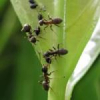The IUCN Red List can be a useful tool for conservationists, but I don't think it works well for this intended purpose.
The list itself--at least, in its present iteration--contains all species which may have, at any point, been of some conservation concern. This includes those which have been assessed and determined not to be of concern. From the IUCN:
"Plants, fungi and animals that have been evaluated to have a low risk of extinction are classified as Least Concern. The Least Concern assessments did not appear on IUCN Red Lists produced before 2003 (except for a few that were listed in 1996) because the main focus of attention has been on threatened species. However, for the sake of transparency and to place threatened assessments in context, all Least Concern assessments are now included on The IUCN Red List. Thus, despite its title, The IUCN Red List of Threatened Species™ does not just focus on threatened species; it considers the status of all species across an increasing number of taxonomic groups."
If you consider species on the Red List in categories of concern (Vulnerable VU, Endangered EN, and Critically Endangered CR), the number of species drops down to a quarter of the total number. If you consider ants which are listed in those categories, that number is 142 species, which highlights another potential issue that can be problematic with the IUCN's list. All 142 of those species are listed as "needs updating," which means no one from the IUCN or affiliates have assessed the status of that species in some time--often on the order of decades. Some of those species may no longer be of concern, or, with more robust assessment, may not have needed to be listed at all.
And finally, the IUCN's list is not comprehensive. In the United States, we have the Endangered Species Act at the federal level, and various other lists in each state at the local level. Many species, subspecies, and what we identify as evolutionarily significant units (ESUs) listed under the ESA aren't on the Red List. Other countries and organizations have their own lists, as well.
I don't mean to sound like I'm putting down the IUCN; I'm not. I've used the Red List in my work before, and it is a helpful tool. If your concern is with accidentally keeping threatened or endangered ants, I would advise checking for listed species with your local organizations. I'm not sure what organization that would be for Ireland, but in developed countries, government-level organizations typically have more up to date information and assessments for locally occurring species.
Edited by Cameron C. Thomas, August 22 2017 - 11:43 AM.















